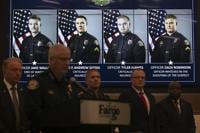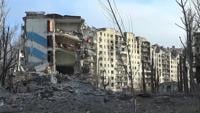BISMARCK, N.D. (AP) — More video recordings of an ambush of police officers in Fargo, North Dakota, show how the gunman cased the scene of a fender bender, waiting and watching for roughly four minutes as more officers arrived before opening fire.
The additional videos — from officers' body cameras, a police dashboard camera and a nearby business — were showed to The Associated Press and other media by North Dakota Attorney General Drew Wrigley.
“It’s fair to deduce from all of this that he is clearly targeting the police,” Wrigley told the AP.
“He seemed to be waiting, and by waiting, doubled the number of police officers that were there,” but that “doesn’t speak to motive of why he did it," the attorney general said.
As the investigation wraps up, the FBI is helping to interview people who exchanged “unremarkable” amounts of money with gunman Mohamad Barakat before the July 14 shooting, Wrigley said.
The attorney general has said Barakat appeared to be an example of the “lone wolves” concept, and there’s no indication anyone helped him.
Barakat lived alone in an apartment, working odd jobs for money. He had no criminal record or social media presence, authorities said, and had so little contact with others that the only photo investigators have provided is a blurry image taken from a video.
Authorities have said Barakat loaded his car with guns, ammunition and explosives and was likely planning a larger attack in the Fargo area. Then he happened upon the fender bender, and may have ambushed the officers to create a diversion.
Barakat shot and killed Jake , who managed to fire one round before he died, and wounded Officers Andrew Dotas and Tyler Hawes along with Karlee Koswick, a woman who had rear-ended another vehicle in the crash. All three have since .
In the videos, Barakat can be seen driving around the area and parking twice in an adjacent parking lot as people came and went amid busy traffic and firefighters responded to the crash. The rear-ended vehicle parked just feet away from Barakat, carrying several other people who soon found themselves ducking for their lives.
Barakat appeared to wait until the three officers moved closer, into a grassy area between the parking lot and street, to interview crash witnesses. He opened fire from his vehicle, with no apparent warning, using a .223-caliber rifle that had had been to unleash a torrent of bullets, some of which hit passing cars and nearby homes.
It's just “the winds of fate” that more people weren't wounded, Wrigley said.
A fourth officer, Zach Robinson, was in the street when the gunfire erupted and began firing back with a 9 mm handgun, ducking behind Koswick's car and then rising up to shoot the clip of Barakat's rifle, effectively disabling the weapon, from about 75 feet (23 meters) away. Calling for backup, he says “Send everybody,” and then runs toward danger as Barakat moves between the parked cars.
The video then shows the wounded Barakat on the ground, still waving a handgun and ignoring Robinson's commands to drop the weapon. Ultimately, Robinson fired five more shots. In the end, after nearly two minutes, 21 of the 31 shots Robinson fired had struck the gunman.
Police vehicles then rushed in from all directions, joined by several ambulances. The firefighters already at the scene for the crash ran to the officers' sides; they had backed up their truck, its front tire punctured by gunfire, to block traffic as the bullets flew.
Hawes’ body camera was shot off his chest and landed on the sidewalk, where it captured audio of the gunfire and sirens. Another camera recorded Hawes crawling to Dotas’ side to comfort him after both were shot. Robinson helped a responding officer handcuff the dying gunman, then comfort Dotas as responders cut off his clothing to render aid.
Video recordings also show Koswick run and fall after being shot. She had been on the sidewalk, talking on her phone.
Wrigley had already presented a segment of at a press conference this month, showing the moments leading up to Barakat’s abrupt attack and how Robinson confronted him,
numerous guns, 1,800 rounds of ammunition, a homemade grenade and explosives in Barakat’s vehicle.
Barakat, 37, was a Syrian national who had come to the U.S. on an asylum request in 2012 and became a U.S. citizen in 2019, Wrigley has said. Concerns about his guns prompted in recent years, but he appeared to have acquired the weapons legally.
After the attack, investigators examining Barakat's internet history found that over the past five years, he had searched for terms including “kill fast,” “explosive ammo,” “incendiary rounds,” “mass shooting events,” and one for “area events where there are crowds.” That brought up a news article with the headline, ”Thousands enjoy first day of Downtown Fargo Street Fair,” a day before the shooting.
Robinson is now back on the job, his actions commended by both Wrigley and Fargo Police Chief David Zibolski.










































